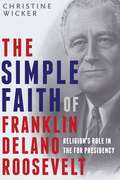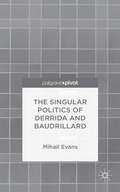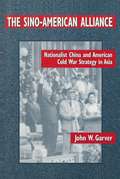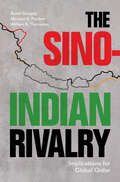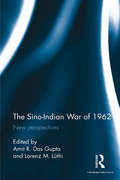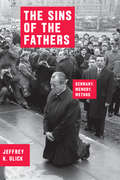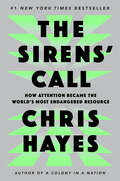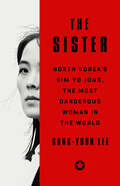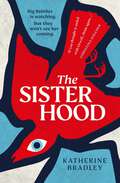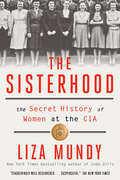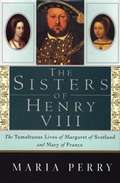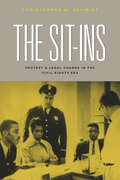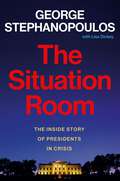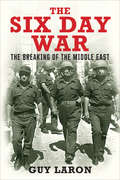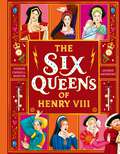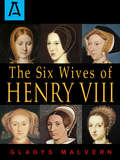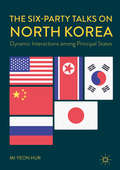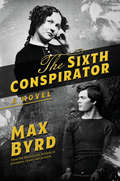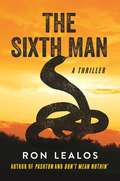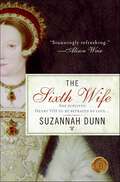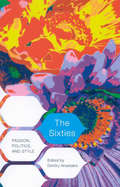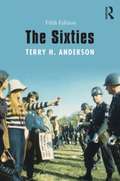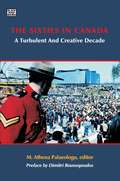- Table View
- List View
The Simple Faith of Franklin Delano Roosevelt: Religion's Role in the FDR Presidency
by Christine WickerIn The Simple Faith of Franklin Delano Roosevelt, religion journalist and author Christine Wicker establishes that faith was at the heart of everything Roosevelt wanted for the American people. This powerful book is the first in-depth look at how one of America's richest, most patrician presidents became a passionate and beloved champion of the downtrodden--and took the country with him. Those who knew Roosevelt best invariably credited his spiritual faith as the source of his passion for democracy, justice, and equality. Like many Americans of that time, his beliefs were simple. He believed the God who heard his prayers and answered them expected him to serve others. He anchored his faith in biblical stories and teachings. During times so hard that the country would have followed him anywhere, he summoned the better angels of the American character in ways that have never been surpassed.
The Singular Politics of Derrida and Baudrillard
by Mihail EvansRecent years have seen the rise of anti-politics as a political phenomenon. Beyond this new rejection of the political class there has long existed a deeper challenge to the political itself. Identifying the work of Derrida as 'a politics' and that of Baudrillard as 'transpolitics' this book charts convergences and divergences in their approaches.
The Sino-American Alliance: Nationalist China and American Cold War Strategy in Asia
by John W. GarverThis study provides an analysis of the role the United States alliance with Nationalist China played in US strategy to contain first the Sino-Soviet alliance and then China during the 1950s and 1960s.
The Sino-Indian Rivalry: Implications for Global Order
by William R. Thompson Šumit Ganguly Manjeet S. PardesiDrawing on a wide body of literature on international rivalries, this comprehensive and theoretically grounded work explains the origins and evolution of the Sino-Indian rivalry. Contrary to popular belief, the authors argue that the Sino-Indian rivalry started almost immediately after the emergence of the two countries in the global arena. They demonstrate how the rivalry has systemic implications for both Asia and the global order, intertwining the positional and spatial dimensions that lie at the heart of the Sino-Indian relationship. Showing how this rivalry has evolved from the late 1940s to the present day, the essays in this collection underscore its significance for global politics and highlight how the asymmetries between India and China have the potential to escalate conflict in the future.
The Sino-Indian War of 1962: New perspectives
by Lorenz M. Lüthi Amit R. Das GuptaThe Sino-Indian border war of 1962 forms a major landmark in South Asian, Asian and Cold War history. Among others, it resulted in an unresolved conflict permanently hindering rapprochement between China and India, the establishment of the Sino-Pakistani axis, the deepening of the Sino-Soviet split and had a lasting impact on Indian domestic affairs. This volume draws on new documentary evidence to re-evaluate perceptions, motivations and decision-making processes of both antagonists, but also of third powers immediately affected by the conflict. It also investigates the effect on India’s internal politics, its Constitution, the Communist Party of India and the fate of Indians of Chinese origin. Finally, it analyses how the conflict is viewed in India today and its ramifications for India–China relationship. A major intervention in the Asian historical landscape, this book will be indispensable to scholars and researchers of modern history, especially of modern South Asia and China, international relations, defence and strategic studies, international politics and government. It will also be useful for think-tanks and government agencies.
The Sins of the Fathers: Germany, Memory, Method
by Jeffrey K. OlickNational identity and political legitimacy always involve a delicate balance between remembering and forgetting. All nations have elements in their past that they would prefer to pass over--the catalog of failures, injustices, and horrors committed in the name of nations, if fully acknowledged, could create significant problems for a country trying to move on and take action in the present. Yet denial and forgetting carry costs as well. Nowhere has this precarious balance been more potent, or important, than in the Federal Republic of Germany, where the devastation and atrocities of two world wars have weighed heavily in virtually every moment and aspect of political life. The Sins of the Fathers confronts that difficulty head-on, exploring the variety of ways that Germany's leaders since 1949 have attempted to meet this challenge, with a particular focus on how those approaches have changed over time. Jeffrey K. Olick asserts that other nations are looking to Germany as an example of how a society can confront a dark past--casting Germany as our model of difficult collective memory.
The Sirens' Call: How Attention Became the World's Most Endangered Resource
by Chris HayesFrom the New York Times bestselling author and MSNBC and podcast host, a powerful wide-angle reckoning with how the assault from attention capitalism on our minds and our hearts has reordered our politics and the very fabric of our society. <p> We all feel it—the distraction, the loss of focus, the addictive focus on the wrong things for too long. We bump into the zombies on their phones in the street, and sometimes they’re us. We stare in pity at the four people at the table in the restaurant, all on their phones, and then we feel the buzz in our pocket. Something has changed utterly: for most of human history, the boundary between public and private has been clear, at least in theory. <p> Now, as Chris Hayes writes, “With the help of a few tech firms, we basically tore it down in about a decade.” Hayes argues that we are in the midst of an epoch-defining transition whose only parallel is what happened to labor in the nineteenth century: attention has become a commodified resource extracted from us, and from which we are increasingly alienated. The Sirens’ Call is the big-picture vision we urgently need to offer clarity and guidance. Because there is a breaking point. <p> Sirens are designed to compel us, and now they are going off in our bedrooms and kitchens at all hours of the day and night, doing the bidding of vast empires, the most valuable companies in history, built on harvesting human attention. As Hayes writes, “Now our deepest neurological structures, human evolutionary inheritances, and social impulses are in a habitat designed to prey upon, to cultivate, distort, or destroy that which most fundamentally makes us human.” <p> The Sirens’ Call is the book that snaps everything into a single holistic framework so that we can wrest back control of our lives, our politics, and our future. <b>New York Times Bestseller</b>
The Sister: North Korea's Kim Yo Jong, the Most Dangerous Woman in the World
by Sung-Yoon LeeThis first book on Kim Jong Un&’s increasingly powerful sister, tapped to be his successor, offers jaw-dropping insights into the latest generation of North Korea&’s secretive and murderous dynasty. The first woman ever to issue the threat of a nuclear weapons strike is not even officially a head of state. Kim Yo Jong is the sister of North Korea&’s Supreme Leader Kim Jong Un and, as their murderous regime&’s chief propagandist, internal administrator, and foreign policymaker, she is the most powerful woman in North Korean history. Cruel but charming, she threatens and insults foreign leaders with sardonic wit, issuing proclamations and denunciations in her own name, a first for any woman in the Korean royal family. She memorably called the South Korean Defense Minister &“a senseless and scum-like guy&” before going on to promise South Korea &“a miserable fate little short of total destruction and ruin&”. A princess by birth with great expectations for her macabre kingdom, she was brought up to believe it is her mission to reunite North Korea with the South or die trying. She&’s ruthless and incredibly dangerous. The Sister, written by Sung-Yoon Lee, a scholar of Korean and East Asian studies and a specialist on North Korea, is a fascinating, authoritative account of the mysterious world of North Korea and its ruling dynasty—a family whose lust for power entails the brutal repression of civilians, a missile program that can reach the continental US, and the constant threat of global havoc.
The Sisterhood: Big Brother is watching. But they won't see her coming.
by Katherine BradleyPRE-ORDER THE INSTITUTE, THE NEW HIGH-CONCEPT PSYCHOLOGICAL THRILLER BY KATHERINE BRADLEY, OUT SPRING 2025. &‘Frightening and timely, Bradley&’s The Sisterhood is the book everyone should read this year. If you thought it ended with Orwell, think again . . .' CHRISTINA DALCHERVox meets The Handmaid&’s Tale in this feminist reimagining of 1984 In Oceania, whoever you are, Big Brother is always watching you and trust is a luxury that no one has. Julia is the seemingly perfect example of what women in Oceania should be: dutiful, useful, subservient, meek. But Julia hides a secret. A secret that would lead to her death if it is discovered. For Julia is part of the underground movement called The Sisterhood, whose main goal is to find members of The Brotherhood, the anti-Party vigilante group, and help them to overthrow Big Brother. Only then can everyone be truly free. When Julia thinks she&’s found a potential member of The Brotherhood, it seems like their goal might finally be in their grasp. But as she gets closer to Winston Smith, Julia&’s past starts to catch up with her and we soon realise that she has many more secrets than we&’d first imagined – and that overthrowing Big Brother might cost her everything – but if you have nothing left to lose then you don&’t mind playing the game . . . This is a story about love, about family, about being a woman, a mother, a sister, a friend and ultimately about what you would sacrifice for the greater good. 'Fast-paced and suspenseful . . . The Sisterhood's greatest gift, however, may be in its message of hope, capable of surmounting even the most formidable of odds and the most uncertain of futures' KATHERINE J. CHEN, author of Joan 'A gut-wrenching, heart-breaking journey through the looking glass of 1984. Compulsively written, Julia&’s is a story begging to be told' FREYA BERRY, author of The Dictator's Wife 'A shockingly relevant take on a classic' CLAIRE MCGOWAN, author of This Could Be Us 'A dazzling retelling of the classic dystopian novel, which raises profound questions about how society works, and whether or not woman have political agency. I found it memorable, deeply moving, and at times, terrifying' KATE RHODES, author of the Ben Kitto series 'Katherine Bradley has delivered a worthy counterpart to George Orwell's 1984 in this chilling, taut book. It's as claustrophobic as it needs to be; particularly frightening as one looks around and sees that we are voluntarily moving towards Orwell's nightmare. It is nothing short of a triumph' MARA TIMON, author of City of Spies &‘In this highly original take on Orwell&’s 1984– the Big Brother of all dystopian classics – Bradley weaves a complex and engaging plot around the idea of a female resistance to oppressive overlords. Oppressive and creepy, but with real heart&’ A. K. TURNER, author of Body Language
The Sisterhood: The Secret History of Women at the CIA
by Liza MundyThe acclaimed author of Code Girls returns with a &“rip-roaring&” (Steve Coll), &“staggeringly well-researched&” (The New York Times) history of three generations at the CIA, &“electric with revelations&” (Booklist) about the women who fought to become operatives, transformed spycraft, and tracked down Osama bin Laden.&“This masterful book cements Liza Mundy as one of our foremost historians.&”—Kate Moore, bestselling author of The Radium GirlsOne of Kirkus Reviews&’ Most Anticipated Books of the FallCreated in the aftermath of World War II, the Central Intelligence Agency relied on women even as it attempted to channel their talents and keep them down. Women sent cables, made dead drops, and maintained the agency&’s secrets. Despite discrimination—even because of it—women who started as clerks, secretaries, or unpaid spouses rose to become some of the CIA&’s shrewdest operatives.They were unlikely spies—and that&’s exactly what made them perfect for the role. Because women were seen as unimportant, pioneering female intelligence officers moved unnoticed around Bonn, Geneva, and Moscow, stealing secrets from under the noses of their KGB adversaries. Back at headquarters, women built the CIA&’s critical archives—first by hand, then by computer. And they noticed things that the men at the top didn&’t see. As the CIA faced an identity crisis after the Cold War, it was a close-knit network of female analysts who spotted the rising threat of al-Qaeda—though their warnings were repeatedly brushed aside.After the 9/11 attacks, more women joined the agency as a new job, targeter, came to prominence. They showed that data analysis would be crucial to the post-9/11 national security landscape—an effort that culminated spectacularly in the CIA&’s successful effort to track down bin Laden in his Pakistani compound.Propelled by the same meticulous reporting and vivid storytelling that infused Code Girls, The Sisterhood offers a riveting new perspective on history, revealing how women at the CIA ushered in the modern intelligence age, and how their silencing made the world more dangerous.
The Sisters of Henry VIII: The Tumultuous Lives of Margaret of Scotland and Mary of France
by Maria PerryHenry VIII's sisters, neglected by generations of historians, impacted the lives and perceptions of their contemporaries more forcefully than did any of their brother's famous six wives. Maria Perry examines the lives of these extraordinary women and analyzes their influence on European Tudor Age history. Both Margaret and Mary, initially accepted their status as pawns in the dynastic power struggles that raged across sixteenth-century Europe. Margaret became queen of Scotland at age thirteen; family members arranged beautiful Mary's betrothal to the aging King of France when she was twelve. But both women chose their second husbands for love. Margaret bucked convention by marrying and divorcing twice after Henry's advancing armies slaughtered her first husband and kidnapped her children. Mary risked execution by proposing to the handsome Duke of Suffolk. By illuminating the characters of these two historical figures, Perry casts light on other aspects of Tudor England, offering a fresh interpretation of Henry VIII's upbringing and of his relationship with immediate family members. In this eye-opening expose of the intrigue and scandal that simmered just beneath the Tudors' regal image, Perry reveals striking new information about a family that - more than any other - shaped the development of both Reformation England and the modern world. She delivers a new and entirely viable theory about what transpired on the wedding night of Henry's doomed elder brother, Arthur, England's heir apparent, and she presents her own spectacular findings on Henry's illegitimate son, his "worldly jewel," the shadowy Duke of Richmond. Perry rescues two remarkable princesses from the shadows of history and radically challenges popular views of both the king and his era. Actress and writer MARIA PERRY was educated at Somerville College, Oxford. Following a career in journalism, both in England and in Sweden, she undertook a wide spectrum of roles on stage and television and in film. She is a founding member of the London recording group The Poetry People. Her previous books, The Word of a Prince: A Life of Elizabeth I and Knightbridge Woman, both received high acclaim. She lives in London.
The Sit-Ins: Protest and Legal Change in the Civil Rights Era (Chicago Series in Law and Society)
by Christopher W. SchmidtOn February 1, 1960, four African American college students entered the Woolworth department store in Greensboro, North Carolina, and sat down at the lunch counter. This lunch counter, like most in the American South, refused to serve black customers. The four students remained in their seats until the store closed. In the following days, they returned, joined by growing numbers of fellow students. These “sit-in” demonstrations soon spread to other southern cities, drawing in thousands of students and coalescing into a protest movement that would transform the struggle for racial equality. The Sit-Ins tells the story of the student lunch counter protests and the national debate they sparked over the meaning of the constitutional right of all Americans to equal protection of the law. Christopher W. Schmidt describes how behind the now-iconic scenes of African American college students sitting in quiet defiance at “whites only” lunch counters lies a series of underappreciated legal dilemmas—about the meaning of the Constitution, the capacity of legal institutions to remedy different forms of injustice, and the relationship between legal reform and social change. The students’ actions initiated a national conversation over whether the Constitution’s equal protection clause extended to the activities of private businesses that served the general public. The courts, the traditional focal point for accounts of constitutional disputes, played an important but ultimately secondary role in this story. The great victory of the sit-in movement came not in the Supreme Court, but in Congress, with the passage of the Civil Rights Act of 1964, landmark legislation that recognized the right African American students had claimed for themselves four years earlier. The Sit-Ins invites a broader understanding of how Americans contest and construct the meaning of their Constitution.
The Situation Room: The Inside Story of Presidents in Crisis
by George StephanopoulosGeorge Stephanopoulos, the legendary political news host and former advisor to President Clinton, recounts the history-making crises from the place where twelve presidents made their highest-pressure decisions: the White House Situation Room. <P><P> No room better defines American power and its role in the world than the White House Situation Room. And yet, none is more shrouded in secrecy and mystery. Created under President Kennedy, the Sit Room has been the epicenter of crisis management for presidents for more than six decades. Time and again, the decisions made within the Sit Room complex affect the lives of every person on this planet. Detailing close calls made and disasters narrowly averted, THE SITUATION ROOM will take readers through dramatic turning points in a dozen presidential administrations, including: <P><P> Incredible minute-by-minute transcripts from the Sit Room after both Presidents Kennedy and Reagan were shot <P>The shocking moment when Henry Kissinger raised the military alert level to DEFCON III while President Nixon was drunk in the White House residence <P>The extraordinary scene when President Carter asked for help from secret government psychics to rescue American hostages in Iran <P>A vivid retelling of the harrowing hours during the 9/11 attack <P>New details from Obama administration officials leading up to the raid on Osama Bin Laden <P>And a first-ever account of January 6th from the staff inside the Sit Room <P><P> THE SITUATION ROOM is the definitive, past-the-security-clearance look at the room where it happened, and the people—the famous and those you've never heard of—who have made history within its walls. <p> <b>New York Times Bestseller</b>
The Six Day War: The Breaking of the Middle East
by Guy LaronThe author of Origins of the Suez Crisis &“mak[es] us look afresh at the events that led to conflict between Israel and its neighbors&” (Financial Times). One fateful week in June 1967 redrew the map of the Middle East. Many scholars have documented how the Six-Day War unfolded, but little has been done to explain why the conflict happened at all. Now, historian Guy Laron refutes the widely accepted belief that the war was merely the result of regional friction, revealing the crucial roles played by American and Soviet policies in the face of an encroaching global economic crisis, and restoring Syria&’s often overlooked centrality to events leading up to the hostilities. The Six-Day War effectively sowed the seeds for the downfall of Arab nationalism, the growth of Islamic extremism, and the animosity between Jews and Palestinians. In this important new work, Laron&’s fresh interdisciplinary perspective and extensive archival research offer a significant reassessment of a conflict—and the trigger-happy generals behind it—that continues to shape the modern world. &“Challenging . . . well worth reading.&”—Moment &“A penetrating study of a conflict that, although brief, helped establish a Middle Eastern template that is operational today . . . The author looks beyond Cold War maneuvering to examine the conflict in other lights . . . Readers with an interest in Middle Eastern geopolitics will find much of value.&”—Kirkus Reviews
The Six Queens of Henry VIII
by Honor Cargill-MartinWe all know Henry VIII had six wives. But these ladies are FAR too interesting to only be known as wives. Did you know that Catherine of Aragon rallied her troops in full armour while heavily pregnant? Or that Anne of Cleves met Henry VIII BEFORE they married - only she didn't realise, because he was in disguise! Or that it was Catherine Parr who persuaded the king to return his daughters Mary and Elizabeth - two of British history's most famous monarchs - to the line of succession?Get ready to lose your head as the six wonderful women behind the man take centre stage to overthrow her-story. From rumours of scandals and LOTS of lying, to political plays and fabulous frocks, The Six is a story filled with ambition, treason and strong women.
The Six Wives of Henry VIII
by Gladys MalvernGladys Malvern uses her celebrated talent for prose to share the stories of Henry VIII's wives with immense personality and captivating drama. Henry VIII was married to six women during his reign as the King of England. Gladys Malvern characterizes them as The Saint (Catherine of Aragon); The Egotist (Anne Boleyn); The Diplomat (Jane Seymour); The Housewife (Anne of Cleves); The Coquette (Catherine Howard); and The Mother (Catherine Parr). Malvern masterfully tells each of their personal histories and how they intertwined through rivalry, vying for power, political maneuvering, and the hardships of losing favor with the man that seceded the Church of England from Rome for a divorce.
The Six-Party Talks on North Korea: Dynamic Interactions among Principal States
by Mi-Yeon HurThe book traces the past decade of dynamic interactions among the concerned states involved in the Six-Party Talks on North Korean nuclear programs. Unlike existing studies which usually dissect incidents of the talks, the book provides a comprehensive systemic analysis of the Six-Party Talks process from A to Z. These new insights into the nuclear drama in the Northeast Asian region will be of value to scholars, policy makers, and analysts.
The Six-Shooter State: Public and Private Violence in American Politics
by Jonathan ObertAmerican violence is schizophrenic. On the one hand, many Americans support the creation of a powerful bureaucracy of coercion made up of police and military forces in order to provide public security. At the same time, many of those citizens also demand the private right to protect their own families, home, and property. This book diagnoses this schizophrenia as a product of a distinctive institutional history, in which private forms of violence - vigilantes, private detectives, mercenary gunfighters - emerged in concert with the creation of new public and state forms of violence such as police departments or the National Guard. This dual public and private face of American violence resulted from the upending of a tradition of republican governance, in which public security had been indistinguishable from private effort, by the nineteenth-century social transformations of the Civil War and the Market Revolution.
The Sixth Conspirator: A Novel
by Max ByrdThe author of Shooting the Sun blends a spy story with a love story in this tale of the secret mission to find the conspirators in Lincoln’s assassination.The assassination of Abraham Lincoln set off a hysterical burst of international conspiracy theories, with all eyes turning first to Canada—once a hotbed of Confederate plots—and then, as evidence mounted, to the Catholic Church and Rome . . .Now from bestselling author, Max Byrd, comes a long forgotten true story: a confidential mission to track down and capture any Europeans (and fugitive Confederates) who may have aided John Wilkes Booth.Drawn from State Department archives and personal letters and diaries, The Sixth Conspirator recounts the dramatic journey of George H. Sharpe, General Ulysses S. Grant’s real-life spymaster, to three European capitals. Three people travel with him—calculating banker Daniel Keach, Sharpe’s Civil War protegé Quintus Oakes, and former Pinkerton agent Maggie Lawton.One step ahead of them is a mysterious Confederate courier, Sarah Slater, known during the war as “the Veiled Lady,” who may or may not have been Booth’s lover. Behind Sharpe’s team, breathing grimly over their shoulders, are Secretary of State William Seward, brutally mutilated by the knife of one of Booth’s henchmen, and the perversely vengeful, guilt-ridden Secretary of War Edwin Stanton.Along the way Byrd creates a panorama of wonderfully realized characters, great and small, fictional and real. In deeply researched, fascinating historical detail, he carries us back to another reality—the far away mid-nineteenth century world from which our America slowly emerged.Praise for The Sixth Conspirator“From its brilliant and devastating opening scene to its surprising and breakneck conclusion, The Sixth Conspirator takes the last tendril of the Lincoln assassination and weaves it into a compelling, erudite, witty, and wise novel that should secure Max Byrd's place among the premier writers of historical fiction working today. Not to be missed!” —John Lescroart, New York Times–bestselling author of The Rule of Law and The Missing Piece“Taking us through the hideaways and haunts of European capitals in the mid-nineteenth century, this intriguing historical mystery . . . keeps us guessing right up to the last page. As in his highly acclaimed novels, Jefferson, Jackson, and Grant, Max Byrd tells the tale with witty and fast-paced writing that kept me turning pages— eager to know more about the “real” men and women of the era along with the fictional characters of his creation.” —Cokie Roberts, Emmy-winning political commentator and author of Capital Dames: The Civil War and the Women of Washington
The Sixth Man: A Thriller
by Ron LealosA quick wit and a sharp tongue alone won’t be enough for Captain Chyang Fang to survive this case. Someone is murdering high-ranking Vietnamese government officials, so the head of Saigon’s homicide division, Captain Chyang Fang, a troubled Chinese Vietnamese man, is given the task of finding the killer. Hated by almost everyone in Saigon and an outcast in both Chinese and Vietnamese circles, Fang has to rely on his wit, biting sarcasm, and not-so-capable assistant, Sergeant Phan?a man who would rather play on his smartphone than work?to find the killer who leaves toy cobras on the bodies of his victims. With the aid of a hunchbacked coroner who honed his skills watching episodes of CSI, and following a key lead that stretches back to the days of the Vietnam War, Fang is led on an opium-addled journey through modern-day Saigon, and if the killer doesn’t get him, the city and its people surely will. Skyhorse Publishing, as well as our Arcade, Yucca, and Good Books imprints, are proud to publish a broad range of books for readers interested in fiction?novels, novellas, political and medical thrillers, comedy, satire, historical fiction, romance, erotic and love stories, mystery, classic literature, folklore and mythology, literary classics including Shakespeare, Dumas, Wilde, Cather, and much more. While not every title we publish becomes a New York Times bestseller or a national bestseller, we are committed to books on subjects that are sometimes overlooked and to authors whose work might not otherwise find a home.
The Sixth Wife: A Novel
by Suzannah DunnA gripping novel of love, passion, betrayal, and heartbreak in the unstable Tudor court following the death of King Henry VIIIClever, level-headed Katherine Parr has suffered through four years of marriage to the aging and irascible King Henry VIII—and she has survived, unlike the five wives who came before her. But less than a year after the old king's death, her heart is won by the dashing Thomas Seymour, and their hasty union undoes a lifetime of prudent caution.An unwilling witness to the queen's late-blossoming love, Catherine, Duchess of Suffolk, harbors nagging suspicions of Kate's handsome and ambitious new husband. But as Catherine is drawn deeper into the web of politics ensnaring her oldest friend, it gradually becomes clear that she has her own dark tale to tell. For though Thomas might betray his wife for power, Catherine might betray her for passion, risking everything she has in a world where love is a luxury not even royalty can easily afford.
The Sixties
by Dimitry AnastakisThose who didn't live through the Sixties wonder what the fuss was all about, while many of those who were there have wrestled with how to describe and define the period. While the ultimate meaning of the Sixties remains elusive, there is no doubt that they had an immense effect on Canadians - culturally, politically, and economically. The Sixties takes a multidisciplinary approach that includes history, architecture, art, political science, and journalism. Contributors examine a range of eclectic issues - from the intersection of Joyce Wieland's artwork with Pierre Trudeau's nationalism, to the debate over the changing skylines of Toronto and Montreal, to de Gaulle's famous 1967 "Vive le Québec libre!" speech - to provide a distinctly Canadian perspective on one of the liveliest and most debated periods in modern history. Four decades after Canada's own Expo 67 "summer of love," this timely book conjures up the images, sounds, and tastes of a decade that remains an indelible part of our twenty-first century experience. Contributors include Gretta Chambers (McGill), Christopher Dummitt (Trent), Olivier Courteaux (Ryerson), Frances Early (Mount Saint Vincent), Kristy Holmes (Queen's), Marcel Martel (York), Nicholas Olsberg (Canadian Centre for Architecture), Francine Vanlaethem (UQAM), and Krys Verrall (York)."
The Sixties
by Terry H. AndersonIn "The Sixties," Terry Anderson tackles the question of why American experienced a full decade of tumult and change, whose reverberations and consequences are still being felt in America today. Always appreciated for its brevity, wit and captivating style, "The Sixties" enters its third edition with expanded coverage of the most interesting and important events, people and movements of the Sixties.
The Sixties in Canada
by M. Athena PalaeologuEverywhere the 1960s are being examined and debated. Universities hold international conferences that bring together scholars and activists. Very little has been published about the sixties in Canada, however. This anthology is meant to close that gap. The essays in this volume reflect a minefield of research material that has been brought together from a rich reservoir of sources, heretofore little known.Contributors include Bryan Palmer, Jonathan Thompson, Anne Hoefnagels, Pat Smart, Sean Mills, Gillian Helfield, Myrna Kostash, John Cleveland, Paul Jackson, Carrie Dickenson, Eric Morton, Barbara Goddard, Laurence Davis, Kristin Ireland, Chris Harris, Kevin Brushett, and Dimitrios Roussopoulos.
